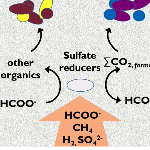Link to online paper: http://www.nature.com/articles/s41598-017-19002-5
Abstract
Hydrogen produced during water-rock serpentinization reactions can drive the synthesis of organic compounds both biotically and abiotically. We investigated abiotic carbon production and microbial metabolic pathways at the high energy but low diversity serpentinite-hosted Lost City hydrothermal field. Compound-specific 14C data demonstrates that formate is mantle-derived and abiotic in some locations and has an additional, seawater-derived component in others. Lipids produced by the dominant member of the archaeal community, the Lost City Methanosarcinales, largely lack 14C, but metagenomic evidence suggests they cannot use formate for methanogenesis. Instead, sulfate- reducing bacteria may be the primary consumers of formate in Lost City chimneys. Paradoxically, the archaeal phylotype that numerically dominates the chimney microbial communities appears ill suited to live in pure hydrothermal fluids without the co-occurrence of organisms that can liberate CO2. Considering the lack of dissolved inorganic carbon in such systems, the ability to utilize formate may be a key trait for survival in pristine serpentinite-hosted environments.
